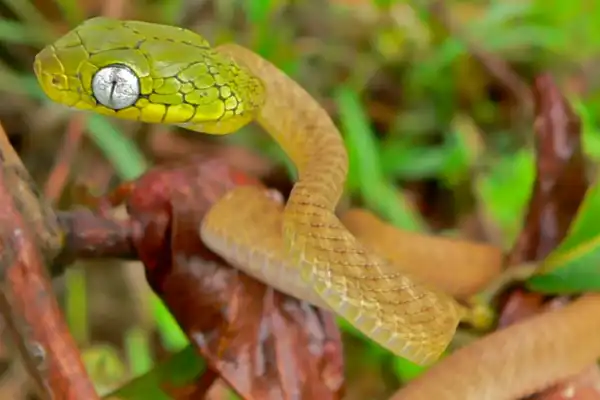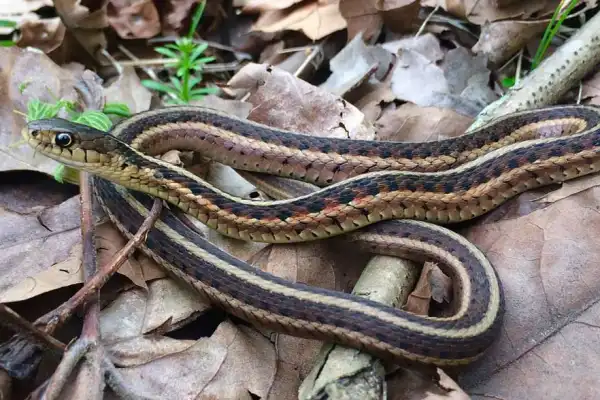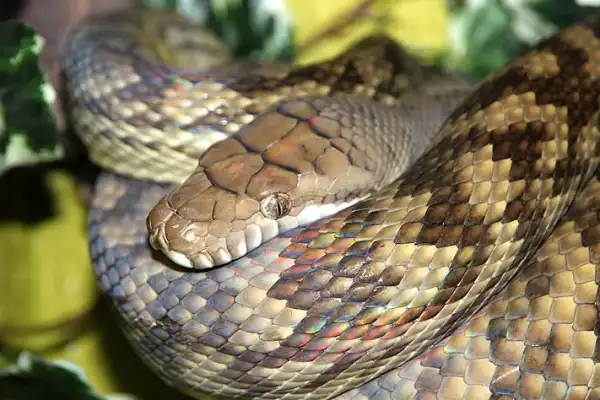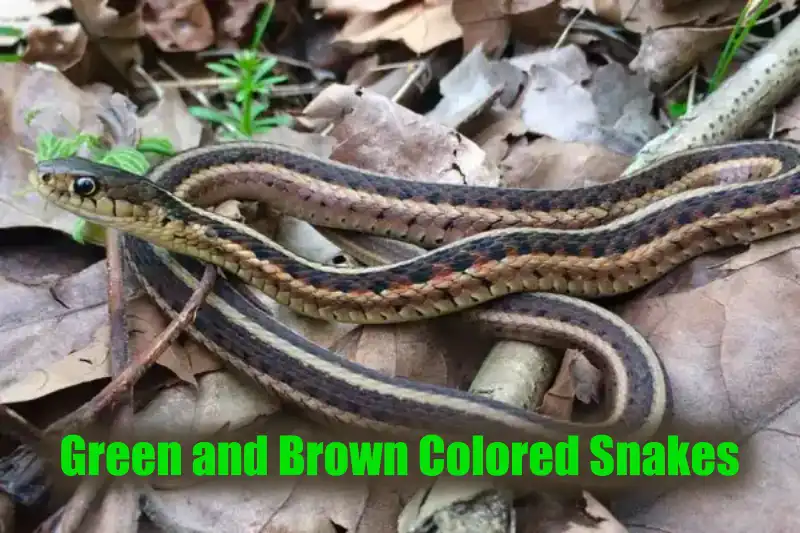Snakes are one of the most dangerous yet beautiful creatures in the world. They show a wide variety of colorations, but not to please us! Rather this helps in camouflage, scare the predators, or lure prey.
Here, we will discuss the world’s 15 green and brown-colored snakes. So without further ado, let us begin.
15 Green and Brown Colored Snakes in the World
1) Green Cat snake (Hatchlings)

- Scientific name: Boiga cyanea
- Size: 1.15 meters to 1.9 meters.
- Habitat: Forest region.
- Location: China, India, Malaysia, Bangladesh.
Although the adult snakes have green coloration, their hatchlings have a unique combination color pattern. The head region is green while the rest of the body is reddish-brown. Only when they reach 8-9 months of age does the color change towards green.
The eyes have a vertical pupil which sometimes resembles that of a cat. The pupils can dilate to appear round. These snakes usually reside in the trees and are nocturnal hunters.
2) Brown-spotted Green Pit Viper
- Scientific name: Trimeresurus venustus
- Size: 70 cm or smaller.
- Habitat: Woods and areas where limestone mountains are present.
- Location: Endemic to Sothern Thailand.
These snakes also go by “Beautiful pit viper”, or ” Brown spotted pit viper”. They are very peaceful in nature and their venom is not very toxic, although there can be slight feelings of pain.
The body is green and covered with brown patches.
3) Arboreal Rat Snake
- Scientific name: Gonyosoma oxycephalum
- Size: Females are larger, up to 8 feet. The males are smaller comparatively.
- Habitat: Usually resides in warm, humid forests, and in tree branches.
- Location: They are endemic to southeast Asia.
The rat snakes have a green-colored body and a dark green head with a light shade of green around the mouth region. They also have a dark horizontal line across their eyes.
They are also called “Red-tailed racers” although their tail color is usually brownish-red or light brown. Their tail is mighty with strong muscles, which not only help them to climb trees or cling to branches, but also to capture and suffocate their prey by constriction.
4) Florida Green water snake
- Scientific name: Nerodia floridana
- Size: 30 to 55 inches.
- Habitat: Dense vegetation and calm waterbodies like swamps, slow rivers, and lakes.
- Location: Found in different parts of southern Georgia and Florida.
These snakes have a mixture of solid greenish-brown color on the dorsal side. The belly or ventral side is whitish in color. Most of them are Diurnal, but some snakes also appear at night.
They preferably feed on larval and adult amphibians and small fishes. They are non-venomous but would not miss a chance to bite if provoked.
5) Southeastern Green Snake
- Scientific name: Philothamnus hoplogaster
- Size: Generally 60 cm in length and can grow up to 1 meter.
- Habitat: Generally found in the Forets and Moist regions of Savanna.
- Location: Native to South Africa.
Although not typically a snake that possesses a combination of green and brown, sometimes brown or dark spots can be seen on the neck region. The belly is yellowish-white with an emerald-green color dorsally.
Sometimes people mistake this snake species for the green mamba (Dendroaspis angusticeps). These snakes are non-venomous and are good climbers as well as swimmers.
6) Plains Gartersnake

- Scientific name: Thamnophis radix
- Size: Ranges between 16 to 42 inches.
- Habitat: Generally found near water bodies.
- Location: Native to the United States.
These snakes have greenish-yellow lateral stripes. The body can show various colors, such as yellow, black, or Brown. A long yellow orangish strip can be seen from head to tail.
They are piscivorous, meaning they prefer to eat fish but sometimes prefer small invertebrates such as earthworms, slugs, etc.
7) Green Anaconda

- Scientific name: Eunectes murinus
- Size: World’s largest snake. Can reach up to 30 feet.
- Habitat: Usually resides in slow-moving rivers, streams, grasslands, and trees.
- Location: Native to the southern regions of South America, Peru, Paraguay, and Trinidad.
Whenever we hear the name Anaconda, it reminds us of the gigantic snake from the film Anaconda. Although the film version is a bit exaggerated, these snakes are huge in reality. They are non-venomous constrictors. The strong muscles in their body provide a strong grip and they can easily suffocate and break the bones of their prey.
Their body color is olive green, or greenish-brown with dark green oval spots on the top and yellow-centered spots on the sides. They remain hidden in thick vegetation and ambush their prey nearby. Green Anacondas can swallow large mammals such as deer or capybara due to their large body size.
8) Amethystine Python

- Scientific name: Simalia amethistina
- Size: 10 to 12 feet on average.
- Habitat: Warm, humid regions, Bushlands, and rainforests.
- Location: Indonesia, New Guinea, northern Australia.
These snakes show multiple colorations, but usually, they are olive-brown with dark bands over the body. They are Venomous with slender bodies.
The name “Amethystine” comes from the fact that their scales shine with a blueish-purple iridescence in sunlight. Like other pit vipers, they have specialized organs or “pits” for heat sensing, which they use to detect prey in their surroundings.
9) Paraguayan Anaconda
- Scientific name: Eunectes Notaeus
- Size: 3.2 to 4.5 meters.
- Habitat: Generally found in swamps, marshes, and slow-moving rivers.
- Location: Parts of South America, such as Paraguay, Brazil, and Argentina.
Did you know that these snakes are excellent swimmers? The genus name “Eunectes” means “good swimmer” in Greek. They are among the giant snakes of the world.
Their body color is usually greenish-yellow or golden-tan, with dark-brown spots or blotches spread over. This pattern is perfect for camouflage in the forest region. They are also known as Yellow Anacondas.
10) Parrot Snake
- Scientific name: Leptophis ahaetulla
- Size: Can grow up to 68 inches.
- Habitat: Moist forests, rainforests, wet forests.
- Location: Argentina, Peru, Trinidad and Tobago, Venezuela.
The body is long and slender, with green, gold, or bronze color. Dark-Brown dorsal scales are present with black edges, which makes them appear more prominent.
Although these snakes are non-venomous, their bite can cause the feeling of a “pin and needle” sensation. Unlike other snakes, their eyes are round and bright.
11) Lichtenstein’s Green Racer
- Scientific name: Philodryas olfersii
- Size: Reaches up to 1 to 1.5 meters.
- Habitat: Semi-arid tropical vegetation, coastal tropical and subtropical forests.
- Location: Argentina, Paraguay, Brazil.
Their overall body color is green, with the top half of the head being brownish. The brown coloration extends from the head to the tail region as a thin line.
Their body is covered with smooth scales. The snakes are mainly arboreal and prefer to live on trees, but sometimes they come down to the ground to hunt. The term “racer” is given since they can move really fast.
12) Black-Bordered Rat Snake
- Scientific name: Ptyas nigromarginata
- Size: Up to 2.26 meters.
- Habitat: Forests.
- Location: They are mainly endemic to Asia.
The dorsal side is green, with the scales having black edges. The head is brownish in color. There are four black stripes present on the posterior side and tail region.
The black-edged scales over the green body give a “net” like appearance. They can be found in the northern regions of Bangladesh, Myanmar, and some parts of China among the places.
13) Western Racer
- Scientific name: Coluber constrictor
- Size: 35 to 75 inches long.
- Habitat: Can be found in wet areas such as marshes, swamps, and dry sunny areas.
- Location: California, Nevada, Western Colorado.
They have a body color which is a mixture of brown and olive. Sometimes black, grey, and blue colorations can be seen. The belly is whitish-yellow.
These snake species are precocial, meaning the hatchlings are active and mature right after birth. They secret a foul-smelling scent from their glands to keep away predators. They are non-venomous and generally solitary.
14) Spiny Bush Viper
- Scientific name: Atheris hispida
- Size: Between 0.68 to 0.73 inches.
- Habitat: Primarily found in rainforests.
- Location: Parts of Central Africa.
We all have seen massive and beautiful dragons in the movies. What if I can show you a real, yet small dragon?
The bush vipers have strong elongated scales, and they stick out from their bodies. Due to this they almost appear like a dragon, although they don’t breathe fire!
They are highly venomous and show a variety of colors like brown, green, yellow, blue, or a mixture.
15) Malabar Pit Viper
- Scientific name: Craspedocephalus malabaricus
- Size: Usual length between 50-60 cm, but can reach a maximum length of 105 cm.
- Habitat: Tropical evergreen forests.
- Location: Found in different regions of India such as Tamil Nadu, and Goa.
The snakes have a body color ranging from green or olive green to brownish, with dark-brown spots arranged in a “zig-zag” manner. Such coloration gives them a fine camouflaging ability in their native habitat.
Like other pit vipers, they have special heat-sensing pits located between the eye and nostril. They are viviparous, meaning that these pit vipers give birth to live young, rather than laying eggs.
Conclusion
The combination of green and brown coloration is quite rare among the snakes. Apart from the snakes discussed here, other combinations of colors exist in the slithery reptilian world, but that is a topic for another day.
Also Read:
Hi everyone. I am Sagnik. Biology has always fascinated me since my school days and that interest motivated me to pursue a Bachelor’s degree in Zoology and a Master’s degree in Biotechnology. I learned a lot of new interesting facts and information regarding the biological world we are part of. After obtaining my degree, I started working as a biology teacher through which I am able to teach students the various concepts that I have learned. Apart from my love for this subject, my passion lies in music, and I teach guitar as well. Photography, Reading comics, Drawing, and video editing are some of my other hobbies. I welcome you to a journey with me, where I will share my knowledge and excitement for the living world through my writings with you all.
